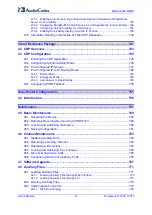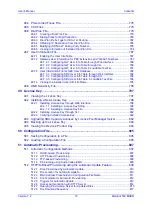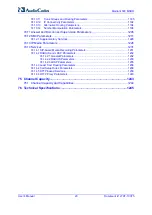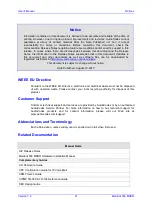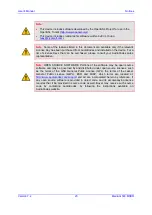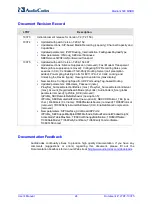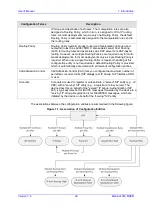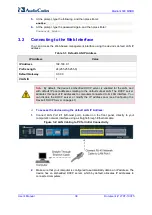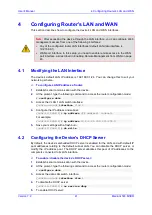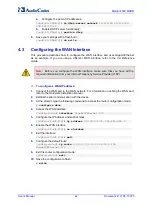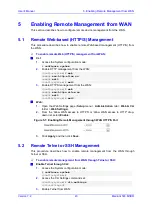
User's Manual
28
Document #: LTRT-10375
Mediant 500 MSBR
Configuration Terms
Description
involved with SRD configuration.
Multiple SRDs are required only for multi-tenant deployments, where it
"splits" the device into multiple logical devices. For multiple SRDs, the SRD
can be configured with a Sharing Policy. The Sharing Policy simply means
whether the SRD's resources (SIP Interfaces, IP Groups, and Proxy Sets)
can be used by other SRDs. For example, if all tenants route calls with the
same SIP Trunking service provider, the SRD of the SIP Trunk would be
configured as a
Shared
Sharing Policy. SRDs whose resources are not
shared, would be configured with an
Isolated
Sharing Policy.
IP Profile
The IP Profile is an optional configuration entity that defines a wide range
of call settings for a specific SIP entity (IP Group). The IP Profile includes
signaling and media related settings, for example, jitter buffer, voice
coders, fax signaling method, SIP header support (local termination if not
supported), and media security method. The IP Profile is in effect, the
interoperability "machine" of the device, enabling communication between
SIP endpoints that "speak" different call "languages".
The IP Profile is associated with the SIP entity, by assigning the IP Profile
to the IP Group of the SIP entity.
Classification
Classification is the process that identifies the incoming call (SIP dialog
request) as belonging to a specific SIP entity (IP Group).
There are three chronological classification stages, where each stage is
done only if the previous stage fails. The device first attempts to classify
the SIP dialog by checking if it belongs to a user that is already registered
in the device's registration database. If this stage fails, the device checks if
the source IP address is defined for a Proxy Set and if yes, it classifies it to
the IP Group associated with the Proxy Set. If this fails, the device
classifies the SIP dialog using the Classification table, which defines
various characteristics of the incoming dialog that if matched, classifies the
call to a specific IP Group. The main characteristics of the incoming call is
the SIP Interface that is associated with the SRD for which the
Classification rule is configured.
IP-to-IP Routing
IP-to-IP routing rules define the routes for routing calls between SIP
entities. As the SIP entities are represented by IP Groups, the routing rules
typically employ IP Groups to denote the source and destination of the call.
For example, to route calls from the IP PBX to the SIP Trunk, the routing
rule can be configured with the IP PBX as the source IP Group and the SIP
Trunk as the destination IP Group.
Instead of IP Groups, various other source and destination methods can be
used. For example, the source can be a source host name while the
destination can be an IP address or based on an LDAP query.
Inbound and Outbound
Manipulation
Inbound and Outbound Manipulation lets you manipulate the user part of
the SIP URI in the SIP message for a specific entity (IP Group). Inbound
manipulation is done on messages received from the SIP entity; outbound
manipulation is done on messages sent to the SIP entity.
Inbound manipulation lets you manipulate the user part of the SIP URI for
source (e.g., in the SIP From header) and destination (e.g., in the Request-
URI line) in the incoming SIP dialog request. Outbound manipulation lets
you manipulate the user part of the Request-URI for source (e.g., in the
SIP From header) or destination (e.g., in the SIP To header) or calling
name, in outbound SIP dialog requests.
The Inbound and Outbound manipulation are associated with the SIP
entity, by configuring the rules with incoming characteristics such as source
Содержание Mediant 500 MSBR
Страница 1: ...User s Manual AudioCodes Family of Multi Service Business Routers MSBR Mediant 500 MSBR Version 7 2 ...
Страница 2: ......
Страница 33: ...Part I Getting Started with Initial Connectivity ...
Страница 34: ......
Страница 36: ...User s Manual 36 Document LTRT 10375 Mediant 500 MSBR This page is intentionally left blank ...
Страница 40: ...User s Manual 40 Document LTRT 10375 Mediant 500 MSBR This page is intentionally left blank ...
Страница 45: ...Part II Management Tools ...
Страница 46: ......
Страница 48: ...User s Manual 48 Document LTRT 10375 Mediant 500 MSBR This page is intentionally left blank ...
Страница 115: ...Part III General System Settings ...
Страница 116: ......
Страница 132: ...User s Manual 132 Document LTRT 10375 Mediant 500 MSBR This page is intentionally left blank ...
Страница 137: ...Part IV General VoIP Configuration ...
Страница 138: ......
Страница 290: ...User s Manual 290 Document LTRT 10375 Mediant 500 MSBR This page is intentionally left blank ...
Страница 306: ...User s Manual 306 Document LTRT 10375 Mediant 500 MSBR This page is intentionally left blank ...
Страница 380: ...User s Manual 380 Document LTRT 10375 Mediant 500 MSBR This page is intentionally left blank ...
Страница 454: ...User s Manual 454 Document LTRT 10375 Mediant 500 MSBR This page is intentionallty left blank ...
Страница 455: ...Part V Gateway Application ...
Страница 456: ......
Страница 458: ...User s Manual 458 Document LTRT 10375 Mediant 500 MSBR IP to Tel Call Figure 24 1 IP to Tel Call Processing Flowchart ...
Страница 460: ...User s Manual 460 Document LTRT 10375 Mediant 500 MSBR This page is intentionally left blank ...
Страница 484: ...User s Manual 484 Document LTRT 10375 Mediant 500 MSBR This page is intentionally left blank ...
Страница 494: ...User s Manual 494 Document LTRT 10375 Mediant 500 MSBR This page is intentionally left blank ...
Страница 625: ...Part VI Session Border Controller Application ...
Страница 626: ......
Страница 654: ...User s Manual 654 Document LTRT 10375 Mediant 500 MSBR This page is intentionally left blank ...
Страница 656: ...User s Manual 656 Document LTRT 10375 Mediant 500 MSBR This page is intentionally left blank ...
Страница 741: ...Part VII Cloud Resilience Package ...
Страница 742: ......
Страница 751: ...Part VIII Data Router Configuration ...
Страница 752: ......
Страница 753: ......
Страница 754: ......
Страница 756: ...User s Manual 756 Document LTRT 10375 Mediant 500 MSBR This page is intentionally left blank ...
Страница 757: ...Part IX Maintenance ...
Страница 758: ......
Страница 834: ...User s Manual 834 Document LTRT 10375 Mediant 500 MSBR This page is intetnionaly left blank ...
Страница 837: ...Part X Status Performance Monitoring and Reporting ...
Страница 838: ......
Страница 848: ...User s Manual 848 Document LTRT 10375 Mediant 500 MSBR This page is intentionally left blank ...
Страница 852: ...User s Manual 852 Document LTRT 10375 Mediant 500 MSBR This page is intentionally left blank ...
Страница 854: ...User s Manual 854 Document LTRT 10375 Mediant 500 MSBR This page is intentionally left blank ...
Страница 878: ...User s Manual 878 Document LTRT 10375 Mediant 500 MSBR This page is intentionally left blank ...
Страница 880: ...User s Manual 880 Document LTRT 10375 Mediant 500 MSBR This page is intentionally left blank ...
Страница 926: ...User s Manual 926 Document LTRT 10375 Mediant 500 MSBR This page is intentionally left blank ...
Страница 927: ...Part XI Diagnostics ...
Страница 928: ......
Страница 950: ...User s Manual 950 Document LTRT 10375 Mediant 500 MSBR This page is intentionally left blank ...
Страница 954: ...User s Manual 954 Document LTRT 10375 Mediant 500 MSBR This page is intentionally left blank ...
Страница 956: ...User s Manual 956 Document LTRT 10375 Mediant 500 MSBR This page is intentionally left blank ...
Страница 958: ...User s Manual 958 Document LTRT 10375 Mediant 500 MSBR This page is intentionally left blank ...
Страница 974: ...User s Manual 974 Document LTRT 10375 Mediant 500 MSBR This page is intentionally left blank ...
Страница 976: ...User s Manual 976 Document LTRT 10375 Mediant 500 MSBR This page is intentionally left blank ...
Страница 977: ...Part XII Appendix ...
Страница 978: ......
Страница 982: ...User s Manual 982 Document LTRT 10375 Mediant 500 MSBR This page is intentionally left blank ...

